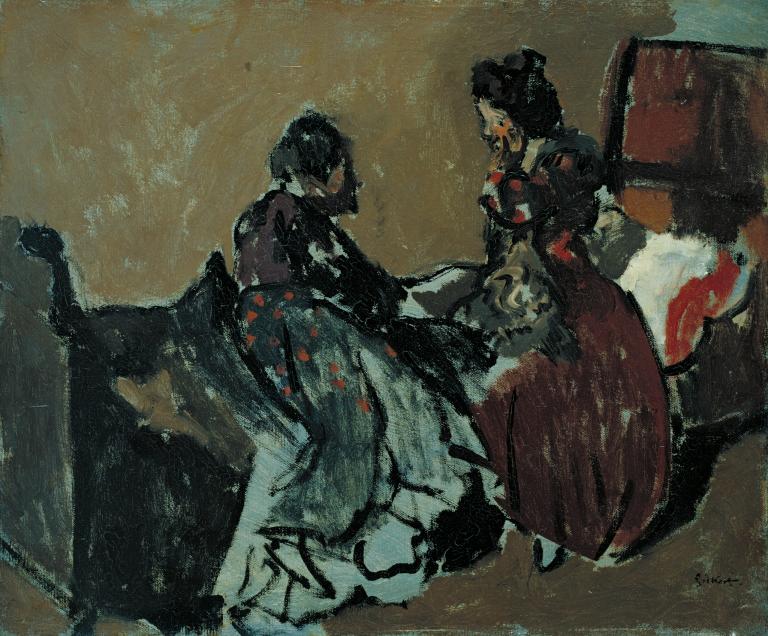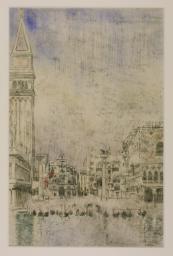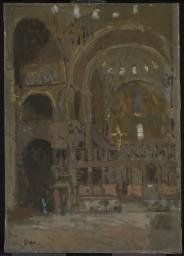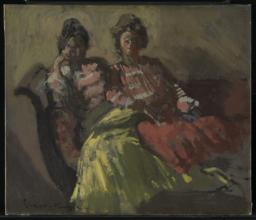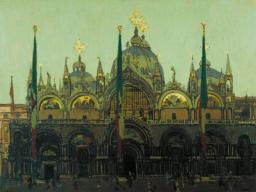Walter Richard Sickert A Marengo c.1903-4
Walter Richard Sickert,
A Marengo
c.1903-4
The two women shown gossiping on a bed, Carolina dell’Acqua and La Giuseppina, were prostitutes who often modelled for Walter Sickert during his time in Venice. In Italy Sickert developed new ideas concerning pairs of figures in interiors that would later inform his ‘Camden Town Murder’ series. The simple colour palette, scant detail and fluid brushstrokes suggest Sickert’s rapid execution, evoking the scene’s immediacy.
Walter Richard Sickert 1860–1942
A Marengo
c.1903–4
Oil paint on canvas
381 x 457 mm
Inscribed by the artist ‘Sickert’ bottom left
Purchased (Clarke Fund) 1922
N03621
c.1903–4
Oil paint on canvas
381 x 457 mm
Inscribed by the artist ‘Sickert’ bottom left
Purchased (Clarke Fund) 1922
N03621
Ownership history
Bought from the artist through Adolphe Tavernier by Bernheim-Jeune, Paris, 17 November 1906; their sale Vente de 84 oeuvres de Walter Sickert, Hôtel Drouot, Paris, 21 June 1909, unsold; R.E.A. Wilson; John Lawrence Rayner of the Eldar Gallery, from whom purchased by Tate Gallery 1922.
Exhibition history
1906
Thirty-Seventh Exhibition of Modern Pictures by the New English Art Club, Dering Yard Galleries, London, November–December 1906 (83).
1909
Vente de 84 Oeuvres de Walter Sickert, Bernheim-Jeune, Hôtel Drouot, Paris, June 1909 (73).
1947
St Ives Society of Artists, New Gallery, St Ives, Cornwall, one month in 1947.
1989–90
W.R. Sickert: Drawings and Paintings 1890–1942, Tate Gallery, Liverpool, March 1989–February 1990, Tate Gallery, London, July–September 1990 (28, reproduced).
2004
Walter Sickert: ‘drawing is the thing’, Whitworth Art Gallery, Manchester, October–December 2004 (3.27, reproduced).
2009
Sickert in Venice, Dulwich Picture Gallery, March–May 2009 (53, reproduced).
References
1941
Robert Emmons, The Life and Opinions of Walter Richard Sickert, London 1941, p.114.
1955
Anthony Bertram, Sickert, London and New York 1955, reproduced pl.20.
1960
Lillian Browse, Sickert, London 1960, p.101.
1964
Mary Chamot, Dennis Farr and Martin Butlin, Tate Gallery Catalogues: The Modern British Paintings, Drawings and Sculpture, vol.2, London 1964, pp.622–3.
1973
Wendy Baron, Sickert, London and New York 1973, pp.80, 336, no.197.
1977
Wendy Baron, Miss Ethel Sands and her Circle, London 1977, p.206 n.20.
1979
Lou Klepac, The Drawings of Walter Richard Sickert, exhibition catalogue, Art Gallery of Western Australia, Perth 1979, p.12.
1992
Wendy Baron and Richard Shone (eds.), Sickert: Paintings, exhibition catalogue, Royal Academy, London 1992, p.144, reproduced fig.117.
2006
Wendy Baron, Sickert: Paintings and Drawings, New Haven and London 2006, no.212, reproduced.
Technique and condition
Sickert bought a canvas in Italy for this painting. He selected a medium-weight but tightly woven cotton fully primed with two layers of lead white mixed with chalk, with no visible separate sizing layer beneath. The cloth is attached to a stretcher of distinctive Italian construction with dove-tailed, cross-section mortice and tenon joints. On the back of the canvas there is a circular red ink stamp that is likely to be a customs stamp.
A thin mid-grey underlayer has been applied over the priming in rough directional strokes, allowing it to show through and imparting a random brushed texture overall. This modifying layer was probably applied by Sickert, who favoured working on this type of grey-coloured ground or darker imprimatura at this time. He sketched the main compositional elements directly onto the modifying layer with a fluid black paint. Rough areas of colour were then applied using a simple palette of dull reds, greens, browns and greys and some white. The paint is fluid and opaque and has been heavily loaded onto a brush allowing the artist to manipulate it on the canvas. Ridges of paint have formed where colour has been loaded onto a brush, pushed and abruptly stopped at the edge of a shape. The colours appear rich and show some incipient drying cracks suggesting that the artist used tube paint, perhaps with a small amount of added medium. There is some mixing of areas of colour on the surface and further application of drawn lines in the same black paint as the initial drawing.
The painting has been varnished but areas appear unfinished leaving the grey underlayer exposed and initial (painted) drawing clearly visible. Overall, the work has the appearance of a spontaneous sketch worked quickly and confidently capturing a moment witnessed by the artist.
Stephen Hackney
July 2004
How to cite
Stephen Hackney, 'Technique and Condition', July 2004, in Robert Upstone, ‘A Marengo c.1903–4 by Walter Richard Sickert’, catalogue entry, May 2009, in Helena Bonett, Ysanne Holt, Jennifer Mundy (eds.), The Camden Town Group in Context, Tate Research Publication, May 2012, https://wwwEntry
A Marengo was painted during the visit Walter Sickert made to Venice between the autumn of 1903 and the summer of 1904. He worked hard on this trip and it was an important time of development in which he evolved new ideas concerning pairs of figures in interiors.1 In Venice, Sickert led an extremely ordered existence, writing to his friend and patron Mrs Hulton on 1 January 1904 that he painted, ‘models from 9 to 11 and 1 to 4, and when the weather is fine a landscape or so’.2 He went on to explain that he got most of his sitters from the restaurant where he usually took his meals, the Giorgione di San Silvestro, run by Signor de Rossi.3
Wanting to be in the heart of bustling Venetian working class life, Sickert took rooms at 1057 Rio Terra di San Silvestro, near the Rialto,4 although he also kept up a studio at 940 Calle dei Frati. The winter of 1903–4 was one of the wettest Venice had experienced, and this led Sickert to abandon view painting and concentrate solely on figure compositions. He wanted to capture the vitality of working class characters in the city: a fisherman with a felt hat, a blind man, and the wrinkled features of the old woman ‘Mamma Mia Poveretta’ all intrigued him.
But more than any others, the models who absorbed Sickert the most were two young women who sat regularly for him: Carolina dell’Acqua and La Giuseppina. Both were prostitutes. Introduced to Sickert by her friend La Giuseppina, Carolina dell’Acqua was reputed to have got her nickname through a fear of water,5 while Sickert himself often referred to her simply as ‘La Carolina’. The dark-haired Giuseppina was one of Sickert’s favourites, and as the solo sitter in his picture Putana a Casa 1903–4 (private collection),6 his title, which translates as ‘Whore at Home’, confirmed her profession. Both women appeared singly in several of Sickert’s paintings, but it is the series of paintings of them paired together, as in A Marengo, that seized his interest.
Sickert wrote to his friend Jacques-Émile Blanche:
From 9 to 4 it is the uninterrupted pleasure of these kind, obliging little models who laugh, to amuse me with smutty talk while posing like angels. They are happy to be there, and are not hurried. By four I am ready only to close the shutters, lie on my bed and sleep the sleep of the just until seven.7
The pictures were made in Sickert’s painting room on the top floor at Calle dei Frati, rather than in his living quarters at Rio Terra di San Silvestro. The bed and other items of furniture, such as the Empire-style sofa in Le Tose (Tate N05296), were essentially studio props, to complete the naturalism of his observations. Pictures such as A Marengo are exercises in the concept of viewing life through a keyhole, which Sickert learned from Edgar Degas. The two girls chat and gossip on the bed in relaxed attitudes that seem entirely natural, but are nevertheless poses that they held for an hour. Their seemingly unselfconscious positioning, however, allowed the viewer the illusion of observing them, as it were, in their natural state, almost like a social anthropologist.
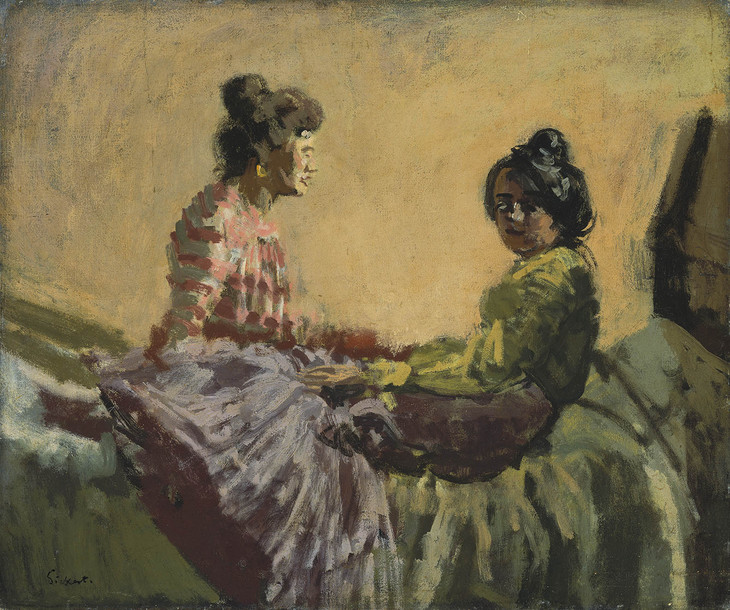
Walter Richard Sickert 1860–1942
Les Vénitiennes (Venetian Women) 1903–4
Oil paint on canvas
457 x 572 mm
Museum of Fine Arts, Boston. Anonymous gift. 38.776
© Estate of Walter R. Sickert / DACS
Photo © 2011 Museum of Fine Arts, Boston
Fig.1
Walter Richard Sickert
Les Vénitiennes (Venetian Women) 1903–4
Museum of Fine Arts, Boston. Anonymous gift. 38.776
© Estate of Walter R. Sickert / DACS
Photo © 2011 Museum of Fine Arts, Boston
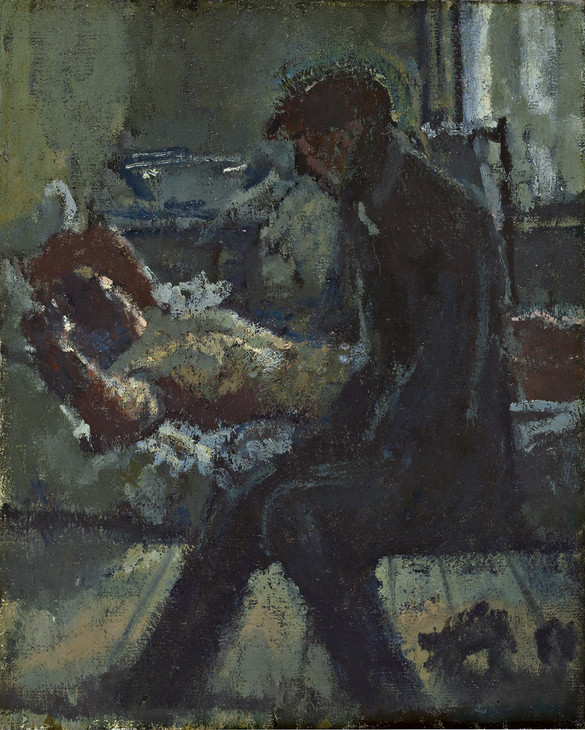
Walter Richard Sickert 1860–1942
Summer Afternoon or What Shall We Do for the Rent? c.1907–9
Oil paint on canvas
515 x 410 mm
Fife Council Libraries & Museums: Kirkcaldy Museum & Art Gallery
© Estate of Walter R. Sickert / DACS
Photo © Antonia Reeve
Fig.2
Walter Richard Sickert
Summer Afternoon or What Shall We Do for the Rent? c.1907–9
Fife Council Libraries & Museums: Kirkcaldy Museum & Art Gallery
© Estate of Walter R. Sickert / DACS
Photo © Antonia Reeve
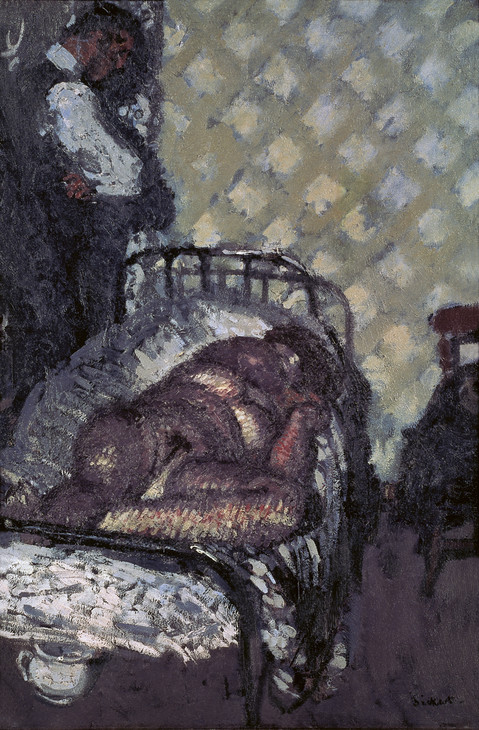
Walter Richard Sickert 1860–1942
L'Affaire de Camden Town 1909
Oil paint on canvas
610 x 406 mm
Private collection
© Estate of Walter R. Sickert / DACS
Photo © Photographic Survey, Courtauld Institute of Art
Fig.3
Walter Richard Sickert
L'Affaire de Camden Town 1909
Private collection
© Estate of Walter R. Sickert / DACS
Photo © Photographic Survey, Courtauld Institute of Art
‘To most contemporary viewers’, Sickert’s biographer Matthew Sturgis has written, ‘two women, whatever the state of their dress or undress, lounging together upon a bed, suggested only one setting: the brothel.’11 In Sickert’s figure pairings there is certainly a subtext of sex, felt most strongly in those pictures where one person is naked. Sickert would have been familiar with Henri de Toulouse-Lautrec’s pictures of brothel scenes, which are often characterised by a similar languid inaction; Degas also made brothel pictures. From his contact with those who knew Sickert, the art historian Denys Sutton believed that Sickert certainly visited a brothel in Venice, so that, in the manner of Toulouse-Lautrec and Degas, he could make sketches.12 Whether Sickert’s relations with Giuseppina and Carolina extended to a physical dimension is unknown, but it seems likely. He admitted he had sex with prostitutes in Venice to his patron Sir William Eden,13 and told Jacques-Émile Blanche that in the winter of 1903–4 he caught his first dose of venereal disease, writing, ‘Enfin me voilà tout à fait “grown up”.’14
In his sequence of Venice figure pictures, Sickert’s aim was to work rapidly and give a sense of immediacy. It was this quality that he described to his friend Nan Hudson in offering her one of the pictures from the series as a gift: ‘Do you remember one I had last Saturday of 2 Venetian girls in shawls, talking? It is one I like for the reason that it was immediately expressed during the pose, & is without thoughts or explanation.’15
To Blanche he detailed his ideal method of painting:
Canvases size 8 prepared in grey (black and white) with oil. A good coat. The first session: everything is laid in from nature covering all the canvas and not permitting the model to move until it is all down. That takes about an hour more or less without moving. When the canvas is covered I start another. Three days or more later (canvases kept round a stove that is always lit) I take up the series again. With a large brush I wash the canvas with linseed oil, which I remove afterwards with blotting-paper, and then I finish off, being guided more by my own work from the first impression, than by the model, and keeping within the proportions first indicated, whether they seem right to me or not.16
The ‘size 8’ canvas Sickert mentions is a French canvas size, measuring 381 x 457 mm, which is the size of A Marengo and most of the other Venice figure pictures. In another letter to Blanche, Sickert stated that he had adjusted his technique, although not his ambition to paint quickly:
I have gained a great deal of experience working from 9 to 4 ... Not to paint in varnish. Not to embarrass the canvas with any preparations. And so to give the paint every possible chance of drying from the back of the canvas. To paint with ½ raw oil and ½ turps. To state general tones once and once only. And when this first coat is dry, to finish, bit by bit. I had the bad habit of re-stating the tones all over an indefinite number of times, and getting no further, not improving the colour, and making the canvas, especially in the darks, more and more disagreeable.17
There is some ambiguity about the title of A Marengo. A ‘marengo’ is an old Italian coin worth about twenty lire, and the apparent concern on the face of the right-hand figure might suggest that either she has lost this amount or needs to find it to pay a debt. This meaning would certainly accentuate the frisson of the scene, implying that the girl may have to sell her body to get the money. Alternatively, Sickert’s biographer Robert Emmons suggested that the title might refer to the famous Battle of Marengo in which Napoleon defeated the Austrians in 1800 near the northern Italian village of that name, after which Napoleon named his horse, so suggesting that Sickert’s scene might be one of disagreement or conflict.18 However, the women look more like they are sharing confidences than arguing, and Emmons’s explanation does not account for Sickert’s use of the definite article in the title. The most convincing explanation is supplied by the art historian Lou Klepac, who has noted Sickert’s tendency to spell foreign names or words incorrectly. In Venetian dialect ‘a remengo’ means ‘to hell with it’, which fits the scene of women gossiping.19 A further possibility is that Sickert may have communicated the title verbally, and it became jumbled when shown in his absence at the New English Art Club in 1906.20
An early owner of A Marengo was R.E.A. Wilson. An old friend of Sickert’s, he founded the Savile Gallery in the mid-1920s. He staged exhibitions of Sickert’s work twice a year, bringing the artist renewed prominence as well as income from healthy sales.21
Robert Upstone
May 2009
Notes
Quoted in Wendy Baron and Richard Shone (eds.), Sickert: Paintings, exhibition catalogue, Royal Academy, London 1992 (34).
Denys Sutton, letter to Wendy Baron, 21 November 1974, Sutton Papers, University of Glasgow Library; see Sturgis 2005, p.330.
Walter Sickert, letter to Sir William Eden, University of Birmingham Library, AP22/23/3; see Sturgis 2005, p.330.
Walter Sickert, letter to Jacques-Émile Blanche, copy in Sutton Papers, University of Glasgow Library; see Sturgis 2005, p.330.
Walter Sickert, letter to Jacques-Émile Blanche, Institut de France, Paris; quoted in Sturgis 2005, p.710 n.62.
Walter Sickert, letter to Jacques-Émile Blanche, Institut de France, Paris; quoted in Sturgis, 2005, p.710 n.62 and in Royal Academy 1992 (34).
Related biographies
Related catalogue entries
How to cite
Robert Upstone, ‘A Marengo c.1903–4 by Walter Richard Sickert’, catalogue entry, May 2009, in Helena Bonett, Ysanne Holt, Jennifer Mundy (eds.), The Camden Town Group in Context, Tate Research Publication, May 2012, https://www

